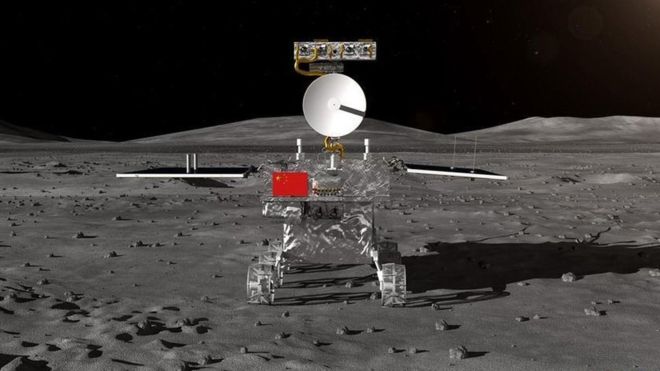The moon has a side it never shows us.
月球有它从不示人的一面。
Humans have flown by it to take pictures and crashed a couple of probes into it,
人类曾飞到它附近拍照,还朝那一面发射了一些探测器,
but we’ve never landed a spacecraft on its surface to get up close and personal with our satellite’s hidden half.
但我们还没能着陆过一艘能接近这颗卫星隐藏的那一面并与其产生亲密接触的宇宙飞船。
Until now.
直到现在。
First though, some clarification.
首先,我们要澄清几个问题。
Sometimes this side of the moon is referred to as “the Dark Side of the Moon.”
有时,月球的这一面被称为“月球的阴暗面”。
That’s inaccurate.
这是不准确的。
The moon is tidally locked with the Earth, meaning one side is always facing us, but the side facing away from us still gets sunshine.
月球是被地球潮汐锁定的,这意味着月球的一面总是朝向我们,但背对我们的那一面也是能被太阳照射到的。
So the more correct term is the far side of the moon, and Dark Side of the Moon is just a killer Pink Floyd album.
所以,更准确的说法是“月球的背面”,而“月球的阴暗面”是平克·弗洛伊德的爆红专辑。
China’s Chang’e-4 probe will be the first spacecraft to poke and prod and study this hidden side of the moon.
中国的嫦娥四号探测器将是第一个探测研究月球这一隐藏面的航天器。
But why go there at all?
但是为什么要探测那一面呢?
A big reason for this mission is, well, because we can.
一个很重要的原因是,因为我们有这个能力。
As the name implies, Chang’e-4 is not the first of its kind.
顾名思义,嫦娥四号并不是第一个首个这种类型的探测器。
The first Chang’e mission, named after the goddess of the moon from Chinese mythology, was an orbiter that launched in late 2007,
嫦娥一号,以中国神话中的月亮女神命名的,是在2007年年底发射的人造卫星,
orbiting the moon for a year and four months before it’s planned impact in march of 2009.
绕月飞行一年零四个月后,按计划于2009年3月撞击月球。
Chang’e-2 was built as a backup to Chang’e-1, and launched in 2010.
嫦娥二号是作为嫦娥一号的备份星研制的,发射于2010年。
It orbited the moon before setting off for the Earth and Sun’s second Lagrange point,
它在绕月飞行后又飞往日地拉格朗日L2点环绕轨道,
and then continued on to fly by an asteroid in 2012.
2012年飞越小行星进行再拓展试验。
Busy little craft.
真是个忙碌的小家伙啊。
Chang’e-3 was China’s first lunar lander, and it touched down in 2013.
嫦娥三号是中国首个登月探测器,于2013年着陆。
Along with the stationary probe was a little rover about three quarters the mass of the Opportunity rover on Mars.
和着陆探测器一起的是一个小巡视器,其质量大约是火星上的“机遇号”巡视器质量的四分之三。
The rover was named Yutu, meaning “Jade Rabbit.”
该巡视器名为“玉兔”,意思是“玉做的兔子”。
Going back to Chinese myth, a rabbit was the goddess Chang’e’s only company out there.
回到中国神话中,兔子是嫦娥在月亮上唯一的陪伴。
Yutu set a record as the longest lived rover on the moon.
玉兔创造了月球上寿命最长的巡视器的记录。
It even discovered a new type of moon rock that helped scientists better understand the moon’s history of volcanism,
它甚至还发现了一种新的月球岩石,帮助科学家更好地了解了月球的火山活动史,
which brings us to the present day.
我们的月球探测也才有了今天的水平。
Like Chang’e-2, Chang’e-4 was built as a backup in case the Chang’e-3 mission failed.
和嫦娥二号一样,嫦娥四号也是为了预防嫦娥三号任务失败而研制的备份星。

But it didn’t, so why not go bigger and bolder with the spare?
但嫦娥三号并没有失败,所以,为什么不用备份星来做些更宏伟更大胆的事呢?
With an upgraded suite of instruments and experiments,
有一套升级的仪器和试验加持,
Chang’e-4’s mission became to explore the far side of the moon.
嫦娥四号的任务是探索月球的背面。
The exact destination is near the south pole inside an enormous crater, the largest crater on the moon in fact.
确切的目的地是在月球南极附近的一个巨大的火山口内,该火山口实际上是月球上最大的火山口。
The mineral composition there is different than other parts of the moon,
那里的矿物质成分不同于月球其他地方的矿物质,
and may be from the inside of the moon that were brought up by an impact.
可能是月球与其他天体发生撞击时从月球内部迁移上来的。
To study their makeup.
研究它们的成分。
Chang’e-4 has spectrometers, along with ground penetrating radar and cameras.
嫦娥四号搭载有光谱仪、探地雷达和照相机。
The craft will also study the effects of solar wind on the lunar surface,
该飞船还将研究太阳风对月球表面的影响,
and it’s brought along plant seeds and silkworm eggs to see if they can grow in the moon’s low gravity.
此外,它还搭载了植物种子和蚕卵,看看它们能否在月球的低引力下生长。
Finally, its place on the far side of the moon makes for an ideal spot to test the feasibility of radio astronomy from there,
最后,它在月球背面的位置刚好是检验射电天文学可行性的理想地点,
since the moon blocks out noise and interference coming from earth.
因为月球挡住了来自地球的噪音和干扰。
Of course if the moon is blocking radio signals,
当然,如果月球挡住了无线电信号,
that makes getting data back from the lander and driving an expensive RC moon car a little more challenging.
那么,从着陆器获取数据和驾驶一辆昂贵的RC月球车也会变得更具挑战性。
To solve that, the Chinese launched a satellite in May of 2018 that is currently orbiting Earth-Moon Lagrange point 2.
为了解决这个问题,中国在2018年5月又发射了一颗卫星,该卫星目前还在绕“地月拉格朗日2点”的轨道运行。
With the relay in place and Chang’e-4 touching down,
接力棒就位,嫦娥四号着陆后,
we can finally learn more about the hidden side of our nearest celestial neighbor.
我们终于能了解距离我们最近的天体邻居不曾示人的一面了。
Like science in your day?
对当下的科学进展感兴趣?
Well you should subscribe!
那你就应该订阅我们的频道!
And although we’re sending a rover to the moon, we actually have a complete map of the surface.
尽管我们正在向月球发射探测器,但我们其实已经有一张完整的月球表面地图了。
Which is a lot more than we can say about mapping our oceans.
而那张地图比海洋地图的信息量要多得多。
But how close are we to a complete ocean map?
但是我们离绘制一张完整的海洋地图还有多远呢?
Check out our video here and make sure to keep coming back to seeker.
这个视频里就有答案噢,还有,别忘了回来看我们更新噢。
Thanks for watching.
感谢大家的收看。











